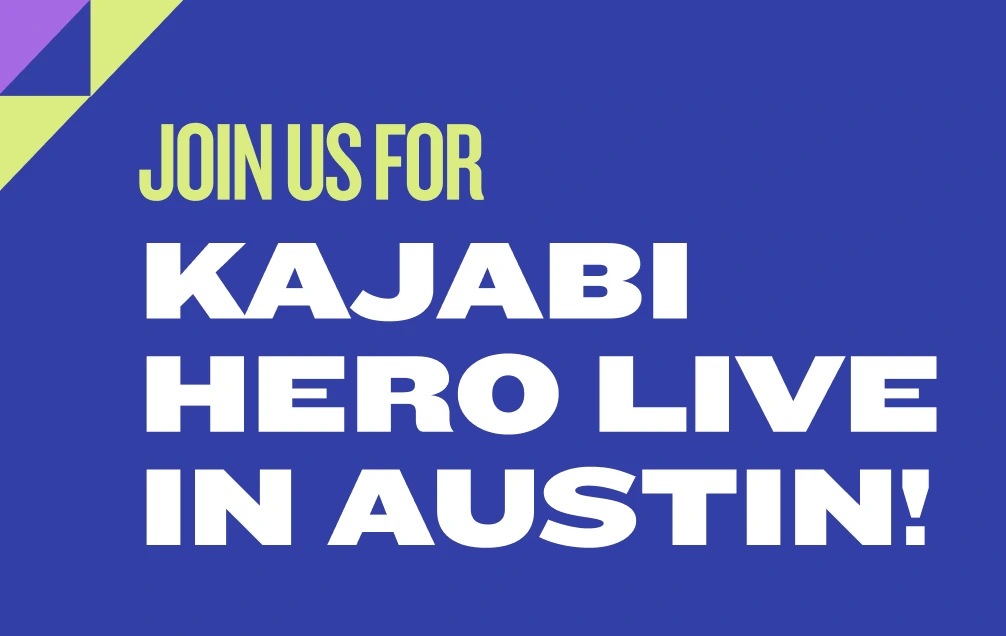
How To Write A Blog Post Series To Launch Your Course
Get free expert insights and tips to grow your knowledge business sent right to your inbox.
There are several ways to warm up your audience for your course launch.
You’re smart. You know that launching takes some preparation.
Throwing your course out there to a cold audience can be hit or miss. But when you prime them for your course launch you can have some great results.
One great way to warm up your audience is to write a blog series to introduce your course.
But writing a blog series doesn’t have to be complicated.
This post will help demystify the process. And I have some valuable tips to make it all flow smoother and quicker than ever.
If you're used to writing 2,000 word blog posts I understand how a series of posts can be intimidating. When you do the math, a series of just 3 posts can run anywhere from 6,000-10,000+ words.
No wonder people get nervous about writing a blog series!
What if I told you that you could easily write a 10,000+ word blog series, without breaking a sweat?
Sounds great right?
In this post I’ll show you how to break each step down into bite-sized pieces without wasting any time.
The Fundamentals of A Winning Blog Post Series
Before we dig into specifics I’m going to break down some basics of what makes a good blog series. In particular, a blog series that leads up to your course launch.
Every blog post has a beginning, middle, and end.
The beginning or introduction explains what your post is about, and what your readers can expect to get out of it. The meat of a post is in the middle, that’s where you deliver the goods. And all of this builds up to the end where you deliver your final conclusions and invite your readers to do something with all of this information; your call-to-action.
A blog series is the same way.
Your first post is the introduction to your series. It should tell your readers what they can expect moving forward and what they’ll get out of it. You can cover some basics they need to know before moving forward, but you won’t dive in too deep just yet.
The middle posts are where you dig into the heart of your series. Each one points to the next ultimately building momentum and anticipation.
The final post is where you bring everything to a close. Then you open the door for your course launch.
If you do a really good job connecting with your audience in your series, most likely, your audience is going to want to experience and learn more from you through your course.
Selecting A Topic For Your Blog Post Series
Even if you don't have your course finished yet, most likely, you already have a good idea of what you want your course to be about.
So how do you come up with the series that complements that?
Let's say, for example, you have a course on how to make your own healthy dog food and dog treats at home.
How could you create a blog post series that opens the door for your course launch in this niche?
- You could write a series about understanding canine nutrition. And once you’ve piqued their interest you can invite them to buy your course to dive even deeper into creating the best diet for their pets.
- You could do a challenge series with different recipes for dog treats and dog food for people to try at home. After experiencing how it improves their pets well being your readers will be eager to unlock the rest of the recipes, and information to improve their dog's’ health.
- You could write a series covering all the tools and supplies you need to create dog food at home, complete with reviews and product suggestions for varying budgets. (Bonus tip: put Amazon affiliate links in your post for some passive income.) After they understand how to use the tools, they can put them to good use by investing in your course.
- You could even take pieces of existing content from your course, and make that into a blog series.
Think of it this way.
If you were your audience, what kind of series would catch your interest, build some excitement, and show you that your course is a good investment?
Batching Your Series to Get It Finished Fast
Chances are, if you’ve been blogging for any length of time, you know how time consuming it can be.
Planning, outlining, writing, editing, finding links, adding images, and making final tweaks; it’s a lot to do. And all of this happens before you even hit publish!
Just thinking about following this same tedious process several times in a row for a blog post series can give you headache.
But there is a way to make writing a blog series a lot easier, and so much faster.
It’s called batching.
Think of it this way…
What makes assembly lines so efficient?
One person has a specific job to do in the assembly line. Instead of jumping from step to step to step they only focus on one thing. Then the next person does the next step and on and on until the product is finished.
The same approach can apply to content creation.
Unless you have a cloning machine, it’s kinda hard to setup a true assembly line. But if you dedicate time and focus into one step in the content creation process at a time, you can finish your series in record time.
You want to know another reason why batching is so productive?
It works well with The Pomodoro Technique.
I am a huge fan of Pomodoro! (Check out this post we put together on how to use it.)
Batching and Pomodoro go together like, well... pasta and tomato sauce!
Now, let’s get into the actual process.
Step 1: Brainstorm Your Blog Series
Brainstorming is about creating a judgement free, low pressure space to let your ideas come out. Your ideas may relate to your series, they may not. But if you censor or restrict random ideas it can close you off to some hidden gems waiting to reveal themselves to you.
Here’s what you’ll need:
- A pen and paper.
- Or your favorite word processor or note taking app. (My favorite is Evernote. It syncs across all my devices for quick, easy reference.)
There are some great benefits to brainstorming on your computer (you’ll see why in the next phase.) But do what frees up your creativity the most.
Set a timer for 25 minutes and write down everything that pops into your mind.
Even if it has nothing to do with your course, it could be an opportunity to clear any fears from your mind related to the series or your course launch in general.
You can write whatever you want in brainstorming mode. Anything goes! But if you’re getting stuck here are some prompts to help guide you through it:
Subjects you need to cover to build interest in your course.
- Ideas you want to explore in the series.
- Who your ideal reader of this content is.
- What is your target word count for each post?
- Ideas for images you can use.
- Any websites or links that come to mind that could help with research or support your ideas.
- How many sections you feel would be good to have in each post.
- How many posts you’d like to have total in the series.
- Any quotes that you’d like to put in the posts.
- Where you’d like to share the series on social media.
- Any calls-to-action you would like in the posts.
These prompts aren’t set in stone. This is just a starting point if you get stuck. And if you get hung up on any of the prompts, just move along. There is no wrong way to brainstorm.
You can even doodle your brainstorm if that’s how you get your creativity flowing.
I’m willing to bet you’ll feel lighter afterward, and see points pop out and connect for a good blog series.
Step 2: Planning Your Blog Post Series With A Basic Outline
There’s a few different ways to approach your outlining.
Knocking them all out in one go before you write any first drafts. Or cycling back from outline to first draft for each post.
Decide which option you want to go with and take a look at your brainstorming exercise. Notice what sticks out to you the most and could stand alone as one post. You want to set these points apart from the rest of the text.
Change the text color, underline it, put it in bold text, whatever you prefer as long as it’s easily distinguishable.
If you're purist who used pen and paper you can either underline or circle of the points that you want to input into your outline. Doodle next to your big ideas if you want to. But don’t put too much time into it. The only one who will see your outline is you…
I guess if you're particularly proud of your outline you could put it on your refrigerator for all your family to see but you get my point.
Pick out two or more of the most important points in your bare bones outline.
Will call these your big ideas. Each of your big ideas will be a separate post in the middle of your series.
So if you can only find 2 or 3 don’t worry about it. Your first and last post already have their big ideas: to introduce and wrap up your series.
When you find your big ideas set them apart from the other points in your basic outline.
Next, start arranging the selected text into bullet points that follow a logical order for your series. Don't be too much of a perfectionist at this stage. And don't be alarmed if it looks like a mess at first.
Here’s an example of what this could look like. (Feel free to use this as a template for your outline.)

After you get your big ideas set up go ahead and select the points that you want to keep from your brainstorming exercise and drag them underneath the big idea where they fit in.
After you have everything organized start adding any points you missed while brainstorming.
What if you get stuck?
Even if you are an expert, knowledge gaps happen. No worries! Make a note in your outline of anything you need to research later and move on.
That's it.
You're not doing yourself any favors by getting hung up. You will fill all those gaps in the research phase.
You can make your outline is detailed or a simple as you need to.
You don’t have to make it pretty either.
As far as spelling errors and grammar hiccups, there’s no need to worry about them. Writing in complete sentences isn’t even necessary.
Most the time, my outlines look like they were written by an English class flunkie who’s had a little too much to drink. But they make sense to me and that's really all that matters
As long as you can understand your outline and know what points you need to cover in your series you’re golden.
Step 3: Researching For Your Blog Post Series
Research is one of those things that you either love or hate. Whichever side of the coin you fall on, research has a way of slowing you down and sucking precious time out of your day.
I’m going to share with you my favorite way to research. It’s the quickest most efficient way that I’ve found, and I hope it can help you too. It's so easy to lose your focus when you're in research mode. This method can help you stay on track.
If you have any gaps in your outline, now is the time to hit up Google for some answers.
Set a timer for 25 minutes.
One by one, start researching all the points in your outline that you skipped over.
Run a Google search and start clicking on articles that apply to your knowledge gap.
Chances are, the content is going to be thousands of words long, but you're only looking for one specific topic. So skim the article until you find a section of text that fills to your knowledge gap.
Select this block of text then copy and paste it above or below your outline or in a separate file.
Go through the content and copy all of the snippets that you need. Then copy and paste the URL either above those snippets or below them. That way if you need to go back to the URL it’s easily accessible.
If the article doesn't have anything useful, move on until you find what you’re looking for.
The sections that you copied and pasted are for your eyes only. You won’t be stealing someone else's content, you’re quickly collecting the information you need in one place for quick reference.
When you’re finished, just fill in the knowledge gaps in your own words from what you’ve learned in your research.
Once you’re outline is finished you’re ready to move on.
Step 4: Write Some Rough First Drafts
Yes, you read that right.
I said rough first drafts.
Your first draft will go a heck of a lot faster if you just crank the thing out instead of stopping to edit or fix spelling errors.
All of the red underlines in your first draft may drive you nuts while you're writing it, but you’ll only add to your frustration if you try to produce a finished product right away.
First drafts aren't meant to be pretty. They can be if that's what you want, but if you're going for speed it's better to crank it out as fast as you can.
Here are a few tips to help you with your first draft:
- Write more words than you want the finished product to be.
Since you are writing this really fast, most likely you're going to do a lot of cutting back before your first draft is ready to be published. - Keep SEO in mind when it comes to word count.
The sweet spot for seo-friendly Content is at least 2,000 words. If you want to go beyond 2,000 words that's perfectly fine too. Feel it out and decide what works best for you and your audience. - Write your first draft at the speed of sound.
Not too many people know about this writing hack, but it could be a total game-changer for you if your typing skills aren't the best.
If you have a Mac you can use the microphone built into your computer to input thousands of words in minutes. You can find this feature by clicking the edit tab on the top left and selecting Dictation. Or hitting the Fn key twice.
Google Docs has its own feature built-in that you can use too.
Click the tools tab then select voice typing. The shortcut for this is Command+Shift+S.
It may take a little more effort to edit and clean up your first draft if you use voice typing, but for me the benefits are worth it. Plus, it’s easier to capture a conversational tone, and passion for your topic that will increase impact. (People may or may not occasionally walk in on me standing at my desk waving my hands while I give my laptop a motivational speech/rant.)
Step 5: Editing And Polishing Your Blog Series
After you finish, it's a good idea to take some time away from your first draft.
When you've been staring at all those words for any period of time, they have a way of blurring together.
You want your eyes to be fresh when you go into the editing phase.
Anywhere from 12-48 hours will give you a fresh perspective to catch more mistakes. After you’ve let your first drafts rest, unleash your inner editor and attack your first draft with a passion.
You can even run your first draft through Grammarly or Hemingway. I wouldn’t rely solely on these tools, but they can speed things up.
After you're done with your editing and polishing it’s a good idea to read your writing out loud, even better, have someone else read it out loud for you. You’ll catch anything you missed by using your eyes and your voice to check for mistakes.
Next add in any links or images, and you’re done!
Here’s a post that can help you make your final drafts near-perfect.
Step 6: Publishing Your Blog Post Series
There are a few different ways that you can actually publish your series.
If you're a highly organized person then you may like to set your blog posts up on a schedule after you've already completed them.
Or you may prefer to publish the series as you go.
The first has an automated feel that it seems effortless. The second one can feel a little more personal and encourage more interaction between you and your audience, like an ongoing conversation.
If you're still working on completing your course, the first option may work out in your favor so you can build your course while still getting feedback from your audience with your series. This is also a great way to validate your course idea and even presell it before it’s finished.
Here are some bonus tips to help you write a blog post series.
- Use your series as an opportunity to build your list.
The beginning and middle of your series is a great opportunity to build you list while warming your audience up to your course. You can do this by encouraging new readers to subscribe to your list so they don't miss the rest of the series. - Don't forget to include links to previous posts in your series as you go.
If someone jumps in on the middle of your series you want the navigation of the series to be easy. If it’s hard to find the rest of your series they can get frustrated and confused if they have to go digging for the rest of the posts. - Use your series to build a wait list for limited enrollment courses.
Your blog post series can still work for you even after your course is closed to new students. At the end of the series to direct them to a waitlist so they'll be the first to know when the course goes live again. You'll have a list of interested people for the next time your course is open.
Create A Blog Series Seamlessly With Kajabi
I know we've covered a lot today but I hope it helps make the process of creating a blog post series easier.
A blog series is a great way to build up excitement over your course, build your list, and connect with your audience on a deeper level before your course goes live.
Even if your audience isn’t very big, that content will be there working for your business indefinitely. But the truth is, most blogging platforms can get complicated. You don’t have to deal with frustrating tech and plugins getting in the way of your content marketing.
With Kajabi you have a website, blog, and course creation platform all built into one. (You can even manage your email marketing too.)
So if you haven't already, think about giving Kajabi a try for 14 days.
With Kajabi, everything is all seamlessly integrated into the platform; no plugins, no tech experience needed, no headaches.
How much easier would that make publishing a blog post series, or content marketing in general if your blog, website, and course platform are all integrated together?
Try it for 14 days completely free and see how easy it is to publish a blog series with Kajabi.
Start Building Your Audience & Sharing Your Knowledge Today on Kajabi
Sign up for your 14-Day Trial now



.jpeg)









